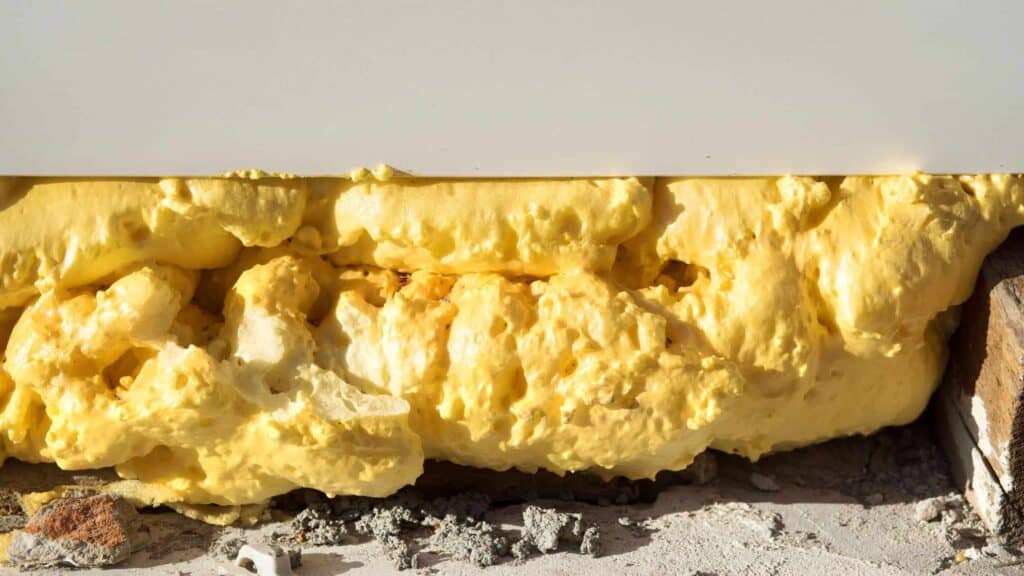In this article, we’ll explore everything you need to know about expanding foam seal, including what it is and where to use it. We’ll also cover how to use expanding foam, and how to care for it.
Expanding foam is a versatile and practical solution for a multitude of home improvement projects. This foam expands to fill gaps and produce a permanent, airtight barrier, making it ideal for sealing gaps and cracks as well as insulating walls and roofs. Many people, however, are inexperienced with this substance and may be unclear about how or where to apply it.
What Is Expanding Foam?
Expanding foam is a polyurethane elastic adhesive sealant. As the ready-to-use spray product is administered, it turns from a “liquid” condition to a “solid” state. When the expanding foam has completely dried, it forms a compact mass that is resistant to impacts, pressures, and weather. After drying, the expanding foam can be sanded and sliced with a stiletto.
Because of its ease of use, resistance to climate action (heat, cold, rain, wind, etc.), and quick drying after application, expanding foam can be utilized for both professional and home purposes. Despite the fact that it is a non-toxic product, some precautions must be taken when using it. Expanding foam is a type of adhesive sealant that is elastic.
What Are the Advantages of Expanding Foam Seal?
The continuous use of expanding foam is justified by the benefits that the product provides at various phases of refurbishment or building. As a result, in addition to learning what expanding foam is, it is critical that you grasp the properties that make this product so appealing.
Here are some of the benefits of using expanding foam:
Easy And Quick Application
The expanding foam comes in spray form and is ready to use. The expanding foam spray valve simplifies use and results in a considerably precise application, resulting in increased project speed and productivity.
Efficient In Sealing Environment
The expanding foam is particularly effective at sealing the environment, making it an excellent choice for preventing the passage of wind or rain (expanding foam seals water).
Good Resistance
When the foam expands, it transforms from a “liquid” to a “solid” state, allowing it to withstand pressure, collisions, and weather.
Controlled Application Without Waste
The expanding foam is delivered ready to use in spray form, ensuring good performance and a considerably more accurate and controlled application.
Excellent Adhesion
The expanding foam adheres well to a variety of surfaces, including wood, iron, brick, plaster, concrete, steel, and aluminum. Furthermore, it can be utilized in a variety of finishes, such as paint and spackle.
Where To Use Expanding Foam Filler?

After all, what is the purpose of expanding foam? Expanding foam is a very versatile product that is resistant to weathering and quite durable, and it can be used for both professional and home applications, both indoors and outdoors.
Internally, expanding foam can be used to:
- Fix and seal the air conditioning
- Fix and seal the electrical energy distribution board
- Install doors and windows
- Fix stops
- Fill expansion joints, coatings, and wedge walls
- Correct defects, cracks, and holes
Expanding foam can be used outside to:
- Install doors and windows
- Fasten stops and seal various types of roofs
- Preventing the entry of animals such as bats, pigeons, birds, skunks, and rats
Smart Uses For Expanding Foam
Expanding foam is a home product that may be used for much more than just insulation. Here are some brilliant uses for expanding foam around the house:
Stop Pipes From Rattling
Water pipes that rumble or rattle when the water is turned on or off eventually become part of our daily soundtrack. So why should they when a little expanding foam can solve the problem? Spray low-expansion foam between the pipe and the structural member against which it rattles. This is usually a penetration through a joist or stud.
Protect Fragile Items
To avoid movement and damage, you may need more than wadded paper or bubble wrap for a piece of fragile electrical equipment or any precious item you need to send or store. Using expanding foam, you may make form-fitting, clamshell-style padding.
Fill Voids Below Concrete
Eroded spaces in the soil beneath concrete sidewalks or patios can cause the surface to break over time, thus, they must be filled. If you have access to the void from the side, shoving soil or sand in will not suffice. Instead, saturate the area with high-expansion foam until it seeps out.
Stabilize Shaky Shower Heads and Faucets
Moving and rattling shower heads are more than simply inconvenient. If they rattle for an extended period of time, they may begin to leak.
While getting behind the shower wall to fix a loose shower head with a strap is usually not practical, the next best alternative is to inject expanding foam behind the wall where the shower head emerges. Preserve your shower surface by using low-expansion foam and working slowly.
Build Waterfalls And Streams – Is Expanding Foam Waterproof?
Natural rocks are frequently used as attractive features in outside garden ponds, waterfalls, and streams, but they can be difficult to keep in place, especially when water is pouring over them.
Put a small amount of black expanding foam under or around the stones to fix them to the lower surface and on their sides to connect them together. Because expanding foam is waterproof, it will not be damaged by splashes from the water feature.
Help Your Cooler Stay Even Cooler
Polypropylene beverages and food coolers often feature hollow lids. While hollow gaps can provide some thermal insulation, expanding foam fills that space better. Make at least two holes in the interior of the cooler’s lid with a drill. One hole should be filled with expanding foam. The second hole will spew foam. Remove the excess foam when it has solidified.
Silence A Noisy Metal Sink
When utilized, metal kitchen or bathroom sinks can be quite loud. Applying low-expanding foam to the bottom of the sink is one approach to reducing the sound. It’s a tricky procedure because you have to work upside down. Work slowly and in small portions at a time, allowing each layer to firm up before proceeding. While working with the foam, make sure to keep the surrounding surfaces safe.
Soften Thumps From HVAC Vents
As long as you have access to the region, HVAC cooling or heating vents that thump when they warm up or cool down can be softened by injecting expanding foam at strategic locations. To begin, locate the portion of the vent that thumps. Then, use expanding foam to fill the space between that location and the nearest structural element, such as a joist or wall stud.
How To Use Expanding Foam Insulation For Doors, Windows, And Roofs

To ensure a satisfactory outcome from the expanded foam, it is critical that the product be applied appropriately, following the processes of site preparation, application, and finishing.
Before spraying the expanding foam, make sure the area is clean and clear of any residues such as cement, oil, grease, or dust. Spray a little water on the area to wet it and aid in the later drying of the expanded foam.
Shake the expanded foam can well before fitting the applicator nozzle, then turn the can upside down to assist product outflow. Close the valve. Because foam expands (increases in size), it is recommended that it be applied to 35% of the area or span.
Spray a little extra water after 10 minutes to avoid the production of bubbles. Let for expansion and drying before finishing with a stylus (cut off the excess volume).
Note: It is preferable to use all of the expanding foam contained within the can. In excess situations, attempt to keep some of the expanding foam at the tip of the applicator nozzle to keep air out.
Precautions When Using Expanding Foam Sealant
Although expanding foam is not harmful, some precautions must be taken when handling it. Among them is flammability. That’s correct, the expanded foam is flammable, so it’s best not to smoke or have any fire sparks close while using it. Avoid getting expanding foam in your eyes, mouth, or skin.
What should you do, and how should you remove expanding foam from your hand? If the expanding foam comes into contact with the skin of the hand, clean it with acetone before thoroughly washing the area with soap and water.
The can with expanding foam must also be stored in a dry and cold environment, avoiding direct sunlight. Additionally, keep the large foam container out of the reach of children and pets.
Expanding foam may be a useful addition to any DIY toolkit, providing a quick and easy solution to a variety of domestic jobs. You can save time and money on repairs and enhancements if you learn how to utilize and care for this product. Expanding foam is a versatile and practical option that can help you achieve your DIY goals, from sealing windows and doors to insulating attics and crawl spaces.
